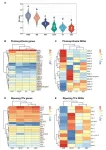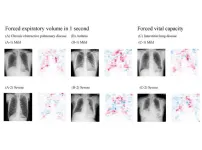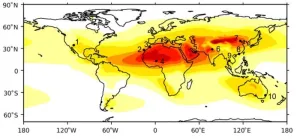(Press-News.org) A new approach to treating the most malignant type of brain cancer – glioblastoma – has shown strong promise in pre-clinical settings, raising hopes of increasing current average survival rates beyond 18 months.
Targeted alpha therapy (TAT) is emerging as a potential additional treatment for glioblastoma (GB), a disease which has confounded oncologists for decades due to its aggressive nature and strong resistance to existing therapies.
The current standard treatment for GB is surgery, followed by external beam radiotherapy and the chemotherapy drug, temozolomide. However, survival rates of less than 5-10% at five years have prompted researchers to explore alternative options.
University of South Australia scientists are conducting their own experiments with TAT and have reviewed existing clinical studies to assess the viability of targeted alpha therapy as a treatment option for recurrent glioblastoma.
In a new paper published in Targeted Oncology, UniSA PhD candidate Maram El Sabri, medical radiation physicist Professor Eva Bezak and oncologist Professor Frank Saran outline the evidence supporting TAT.
“Unlike external beam radiotherapy, which delivers radiation more diffusely over a larger volume, TAT delivers high amounts of lethal radiation to the tumour at very short range, hitting its target without significantly affecting surrounding healthy tissue,” says Maram.
“Alpha particles are up to 10 times more potent, when compared to standard photon radiation therapy, killing the cancer cells or at the very least slowing their future growth by damaging their DNA.”
Glioblastomas are problematic because they grow very quickly and spread beyond the easy visible tumour into normal brain tissue, making it difficult for oncologists to deliver the optimal dosage of radiation needed to kill the cancer.
Animal studies demonstrate that only a few targeting agents can effectively cross the blood brain barrier (BBB) to reach cancerous tissue, and those that do cause unwanted side effects in surrounding healthy tissue.
In pre-clinical experiments, TAT has been shown to increase survival rates by 16.1% in newly diagnosed glioblastoma cases and by 36.4% in recurrent tumours. Furthermore, the studies suggest that it has minimal adverse effects for the patient.
Co-author Professor Bezak says TAT was first proposed for cancer therapy more than 20 years ago by internationally acclaimed Australian research scientist, Professor Barry Allen, who died in 2019 from cancer.
“He was ahead of his time. It has taken this long for TAT to be gradually accepted by clinicians and for animal (pre-clinical) and human (clinical) studies to be undertaken,” Prof Bezak says.
“Pre-clinical studies show very promising results. Alpha emitters are up to 10 times more toxic to cells than gamma radiation, which are used in external beam radiation. Also, compared to the cost of current immunotherapy or molecular targeting drugs, targeted alpha therapy is relatively cheap.”
Professor Frank Saran, an Adjunct Clinical Professor at UniSA and experienced radiation oncologist, says very little progress has been made in the treatment of glioblastoma in recent decades, sparking a renewed interest in TAT.
“The most exciting development was the discovery of the chemotherapy drug temozolomide in the 1980s but that has only improved the expected median survival by around three months,” he says.
“Research into this area is very low for several reasons. First, glioblastoma is a rare cancer so does not affect large swathes of the population. It also has extremely low survival rates and there is a long-standing history of failed studies in this area. Unfortunately, pharmaceutical companies are often not willing to invest money in GB because it has a low probability of success and is not commercially viable.”
In her PhD, Maram is developing a computational model to calculate how TAT can be delivered most effectively to the brain after surgery, and in combination with conventional radiation treatment and chemotherapies, specifically targeting residual cancer cells and delivering more effective radiation to the tumour.
“I am excited to find out if we can find the right dosing and radiation range by adding TAT to the conventional treatment options. If this is successful, we might see some significant results in terms of extending a patient’s life,” she says.
“Targeted Alpha Therapy for Glioblastoma: Review on In Vitro, In Vivo and Clinical Trials” is published in the journal Targeted Oncology. DOI: 10.1007/s11523-024-01071-y
END
Scientists exploring potential new treatments for glioblastoma
Pre-clinical trials show powerful targeted alpha radiation therapy kills brain cancer cells
2024-07-09
ELSE PRESS RELEASES FROM THIS DATE:
Tomato Time capsule: postharvest treatments and their role in ripening dynamics
2024-07-09
Tomato fruit ripening, a process initiated by key gene demethylation, is significantly influenced by postharvest handling practices. These practices, while extending shelf life, can alter ripening dynamics and affect fruit quality. This study explores the impact of various postharvest treatments on the fruit's methylome and transcriptome, shedding light on how physiological and molecular changes interplay to determine the final quality of tomatoes.
Postharvest handling practices, such as refrigeration and modified atmosphere storage, are commonly used to extend the shelf life of tomatoes. However, these methods can negatively impact fruit quality, ...
Innovative, highly accurate AI model can estimate lung function just by using chest x-rays
2024-07-09
If there is one medical exam that everyone in the world has taken, it’s a chest x-ray. Clinicians can use radiographs to tell if someone has tuberculosis, lung cancer, or other diseases, but they can’t use them to tell if the lungs are functioning well.
Until now, that is.
In findings published in The Lancet Digital Health, a research group led by Associate Professor Daiju Ueda and Professor Yukio Miki at Osaka Metropolitan University’s Graduate School of Medicine has developed an artificial intelligence model that can estimate lung function from chest radiographs with high accuracy.
Conventionally, ...
University of Cincinnati, Swing Therapeutics study: Mobile app therapy leads to significant improvement in fibromyalgia management
2024-07-09
New research led by the University of Cincinnati and Swing Therapeutics found that a self-guided smartphone-based behavioral therapy led to significant improvements for patients with fibromyalgia.
The multicenter, randomized controlled trial tested Stanza, a smartphone app that delivers acceptance and commitment therapy (ACT), a type of cognitive behavioral therapy recommended by international clinical guidelines for fibromyalgia management, with the results of the study published July 8 in The Lancet.
Fibromyalgia is a chronic pain condition that affects an estimated 10 million Americans, a majority ...
Anxiety and depression a more common consequence of cardiac arrest for women than for men
2024-07-09
Cardiac arrests affect around 350,000 people in Europe each year with less than 20% surviving an out of hospital cardiac arrest. Research from Amsterdam UMC shows that women who survive consequently have greater rates of anxiety and depression. Furthermore, both men and women are affected by negative population-wide changes in socioeconomic status as they age. Suggesting more support is necessary for those who have suffered a cardiac arrest. These results are published today in Circulation: Cardiovascular Quality & Outcomes.
"We looked at many factors to determine the five-year consequences of a cardiac arrest, here we saw, most significantly, a 50% ...
Engine wear risk as planes swallow more dust waiting to land
2024-07-09
Planes flying into one of the world's busiest airports are ingesting around 10kg of dust per 1,000 flights - with most of this dust ingested while they are waiting to land, new research has revealed.
Scientists used 17 years of ECMWF atmospheric data and data from the CALIPSO satellite to calculate the quantity of sand and dust swallowed by jet engines at ten major international airports located in desert regions or subject to seasonal dust storms.
The global study, published today (Tuesday, 9 July) in the journal Natural Hazards and Earth System Sciences, ...
Coral reefs: battlegrounds for survival in a changing climate
2024-07-09
(Santa Barbara, Calif.) — Coral reefs, those vibrant underwater cities, stand on the precipice of collapse. While rising ocean temperatures and coral bleaching grab headlines, a new essay in Current Biology reveals a hidden layer of complexity in this fight for survival: the often-overlooked roles of the reefs’ smallest inhabitants.
Scientists have long understood the vital partnership between corals and their symbiotic algae, but work by researchers at UC Santa Barbara and University of Georgia highlights how the fate of entire reefs may hinge ...
Study: Telehealth builds autonomy, trust in treating addiction
2024-07-09
Even as the nation’s opioid epidemic continues to ravage families and communities nationwide — with more than 100,000 Americans dying of drug overdoses each year — stigma remains a barrier for many people accessing treatment for addiction.
A new study from Oregon Health & Science University suggests telehealth may be an important antidote to overcoming stigma and reducing barriers for people seeking out the treatment they need.
The study, published recently in the Harm Reduction Journal, compiled in-depth interviews with 30 people treated for substance use disorder ...
New carbon storage technology is fastest of its kind
2024-07-09
A new way to store carbon captured from the atmosphere developed by researchers from The University of Texas at Austin works much faster than current methods without the harmful chemical accelerants they require.
In new research published in ACS Sustainable Chemistry & Engineering, the team developed a technique for ultrafast formation of carbon dioxide hydrates. These unique ice-like materials can bury carbon dioxide in the ocean, preventing it from being released into the atmosphere.
“We’re staring at a huge challenge — finding a way ...
Socioeconomic status significantly affects fertility treatment outcomes, new study shows
2024-07-09
Novel research, presented today at the ESHRE 40th Annual Meeting in Amsterdam, reveals significant social disparities in achieving live births following assisted reproductive technology (ART) treatment. Women with a research education (PhD) were over three times more likely to achieve a live birth compared to those with a primary school education, while women in the highest income group were twice as likely than those in the lowest income group [1].
Conducted by researchers from the University of Copenhagen and Copenhagen University Hospital (Rigshospitalet), the national, register-based study analysed data from 68,738 women aged 18-45 who underwent ...
IVF and IUI treatment cycles increase across Europe, along with stable pregnancy rates
2024-07-09
Women in Europe are receiving more cycles of in vitro fertilisation (IVF) and intrauterine insemination (IUI), according to data presented today at the ESHRE 40th Annual Meeting in Amsterdam [1].
Preliminary data from the ESHRE European IVF Monitoring (EIM) Consortium [2] reveals a steady and progressive rise in the use of Assisted Reproductive Technology (ART). In 2021, a total of 1 103,633 ART treatment cycles were reported by 1,382 clinics across 37 European countries – a 20% increase from the 919,364 cycles reported in 2020, keeping in mind that this was the year COVID affected the number ...
LAST 30 PRESS RELEASES:
Heart-brain connection: international study reveals the role of the vagus nerve in keeping the heart young
Researchers identify Rb1 as a predictive biomarker for a new therapeutic strategy in some breast cancers
Survey reveals ethical gaps slowing AI adoption in pediatric surgery
Stimulant ADHD medications work differently than thought
AI overestimates how smart people are, according to HSE economists
HSE researchers create genome-wide map of quadruplexes
Scientists boost cell "powerhouses" to burn more calories
Automatic label checking: The missing step in making reliable medical AI
Low daily alcohol intake linked to 50% heightened mouth cancer risk in India
American Meteorological Society announces Rick Spinrad as 2026 President-Elect
Biomass-based carbon capture spotlighted in newly released global climate webinar recording
Illuminating invisible nano pollutants: advanced bioimaging tracks the full journey of emerging nanoscale contaminants in living systems
How does age affect recovery from spinal cord injury?
Novel AI tool offers prognosis for patients with head and neck cancer
Fathers’ microplastic exposure tied to their children’s metabolic problems
Research validates laboratory model for studying high-grade serous ovarian cancer
SIR 2026 delivers transformative breakthroughs in minimally invasive medicine to improve patient care
Stem Cell Reports most downloaded papers of 2025 highlight the breadth and impact of stem cell research
Oxford-led study estimates NHS spends around 3% of its primary and secondary care budget on the health impacts of heat and cold in England
A researcher’s long quest leads to a smart composite breakthrough
Urban wild bees act as “microbial sensors” of city health.
New study finds where you live affects recovery after a hip fracture
Forecasting the impact of fully automated vehicle adoption on US road traffic injuries
Alcohol-related hospitalizations from 2016 to 2022
Semaglutide and hospitalizations in patients with obesity and established cardiovascular disease
Researchers ‘listen in’ to embryo-mother interactions during implantation using a culture system replicating the womb lining
How changing your diet could help save the world
How to make AI truly scalable and reliable for real-time traffic assignment?
Beyond fragmented markets: A new framework for efficient and stable ride-pooling
Can shape priors make road perception more reliable for autonomous driving?
[Press-News.org] Scientists exploring potential new treatments for glioblastomaPre-clinical trials show powerful targeted alpha radiation therapy kills brain cancer cells




